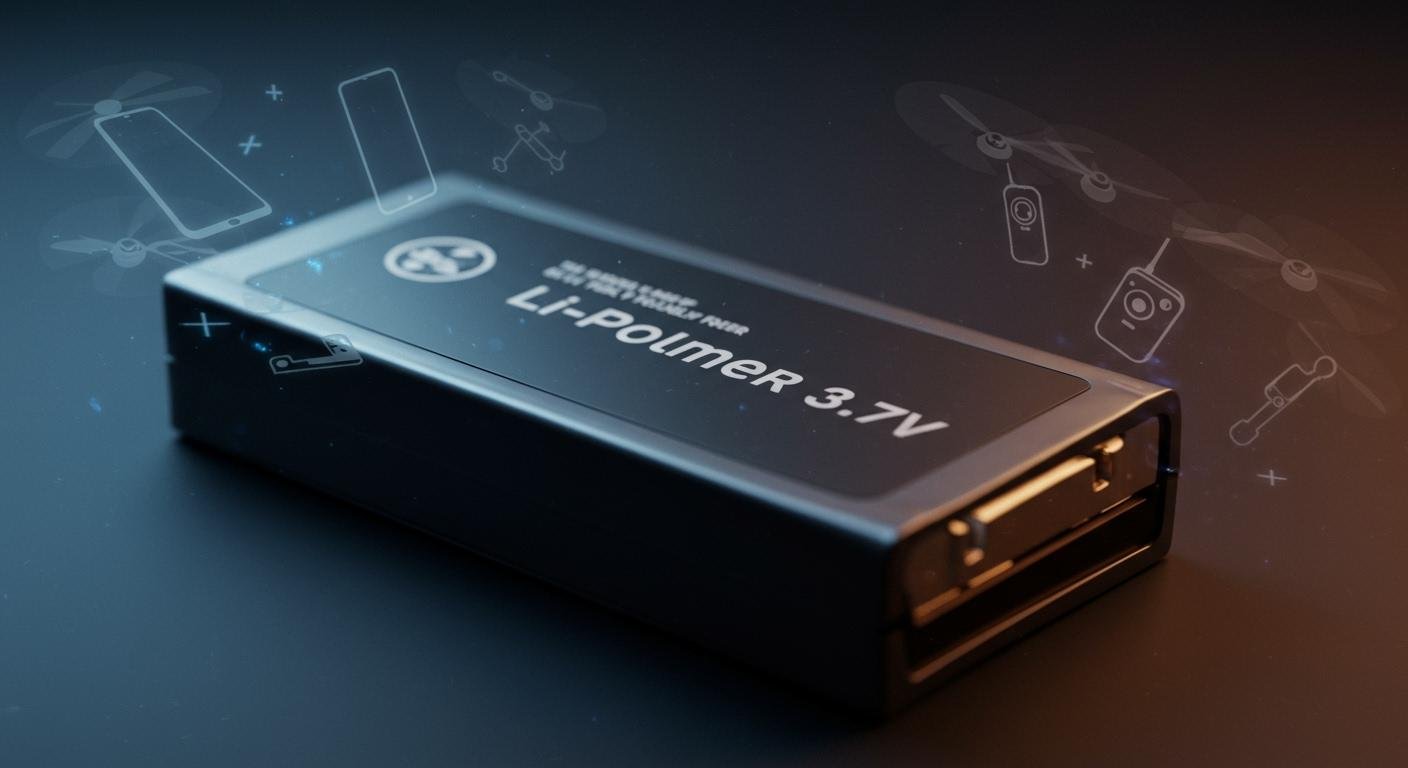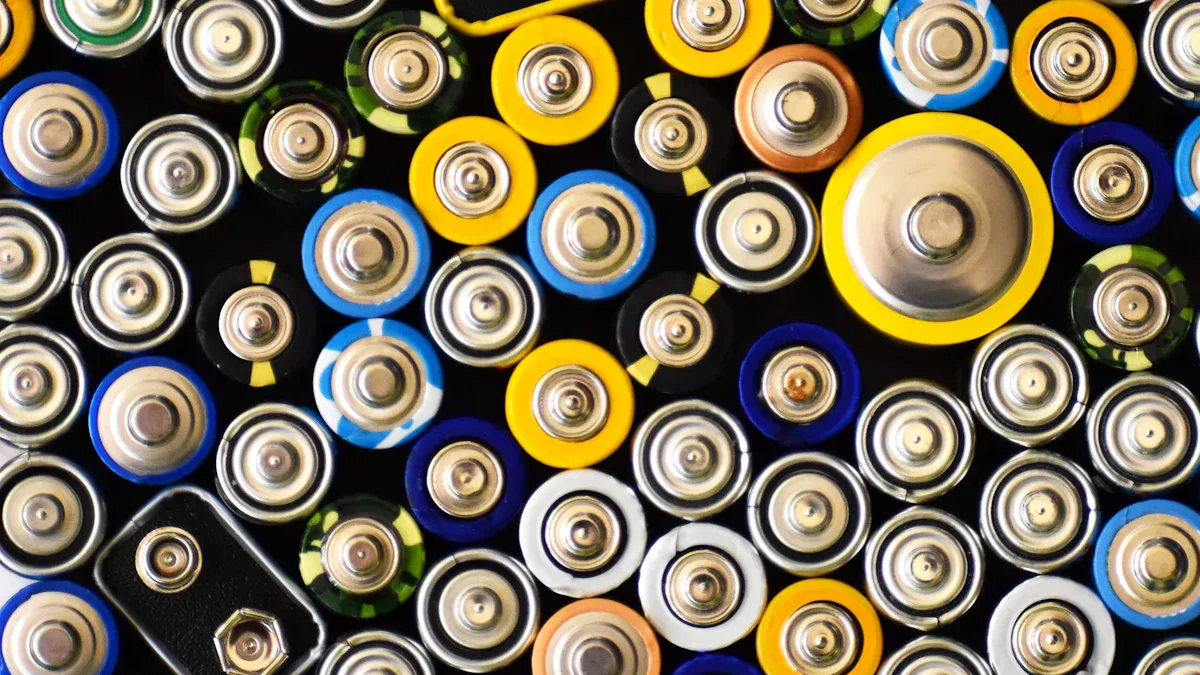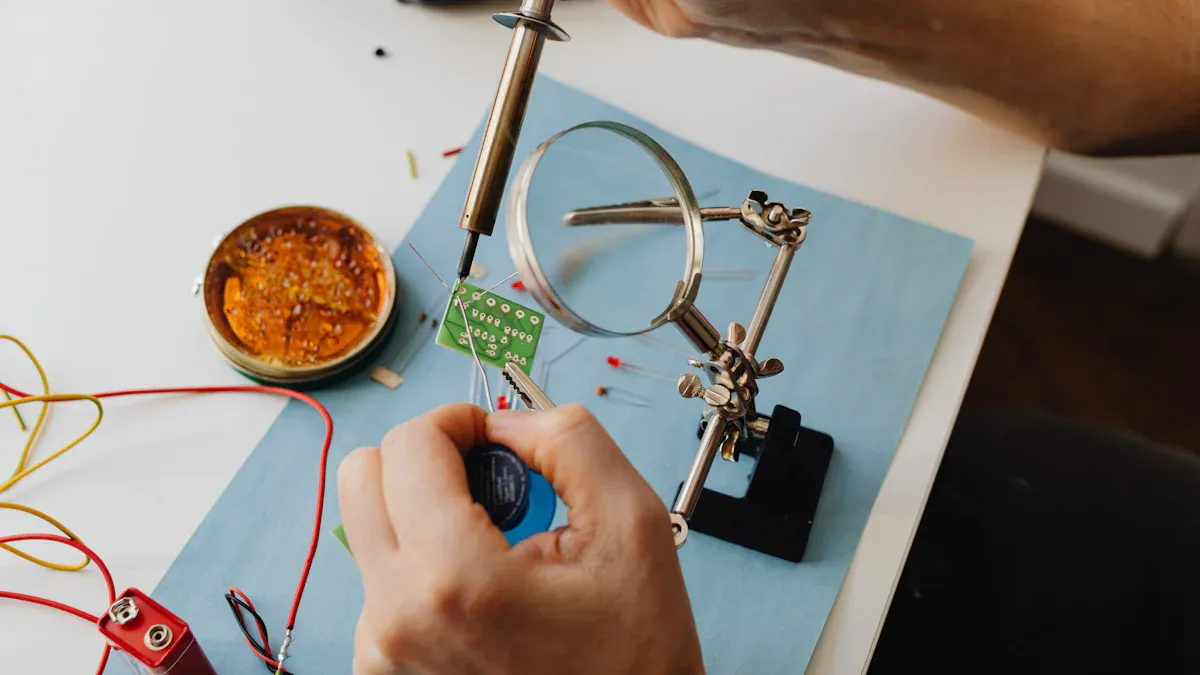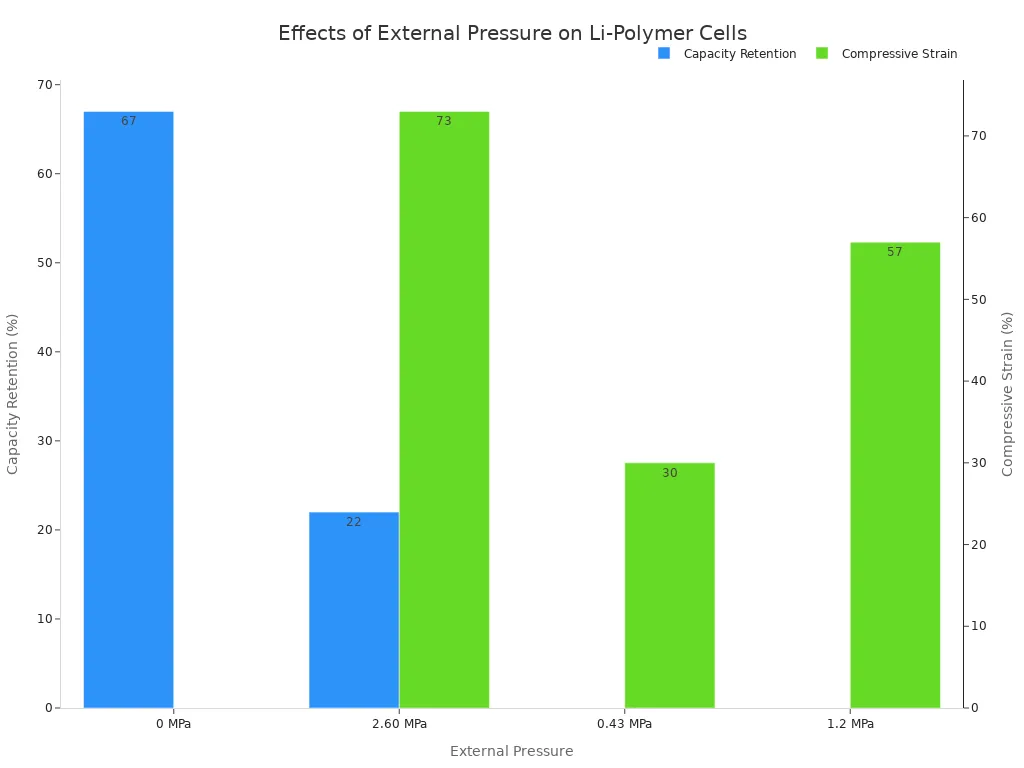
A battery li polymer 3.7v is a high-energy, lightweight power source. This 3.7v battery is a cornerstone of modern portable electronics. Many devices use these 3.7 volt rechargeable batteries, a type of 3.7v lithium battery. Its flexible shape enables diverse applications, powering everything from smartphones to drones. The battery’s unique construction is essential for its overall performance in these compact gadgets.
Understanding the Battery Li Polymer 3.7V

A battery li polymer 3.7v operates across a specific voltage range. This range is critical for device function and battery health. Understanding its chemistry and physical design reveals why it is a top choice for modern electronics.
Nominal vs. Full Charge Voltage
The “3.7V” label on a 3.7v lithium battery refers to its nominal, or average, voltage. This is not its constant output. A fully charged battery reaches 4.2V. As it powers a device, its voltage gradually drops. The discharge cut-off is around 3.0V. Draining the battery below this level can cause permanent damage. These 3.7 volt rechargeable batteries perform best when managed within this voltage window.
Pro Tip: To extend the life of your 3.7v battery, it is best to recharge it when its open-circuit voltage drops below 3.6V, rather than waiting for it to fully deplete.
Core Chemistry of Lithium-Polymer
The power of lithium-polymer cells comes from a simple, elegant process. Inside the battery, lithium ions move between two electrodes: a negative electrode (anode) and a positive electrode (cathode). During discharge, these ions travel from the anode to the cathode through a gel-like electrolyte. This movement creates an electrical current that powers your device. The process reverses during charging. This efficient ion transport is a hallmark of lithium-ion technology and is what gives these cells their high energy density.
Key Advantages and Form Factor
The unique construction of a battery li polymer 3.7v provides several key benefits over a traditional lithium-ion battery. Its main advantage is the use of a polymer gel electrolyte instead of a liquid one. This design offers:
- Enhanced Safety: The gel is less likely to leak, reducing the risk of fire or damage. While these 3.7 volt rechargeable batteries can swell if misused, they are generally more stable.
- Flexible Form Factor: Manufacturers can shape this 3.7v lithium battery into very thin or custom forms. This flexibility is crucial for compact devices like wearables, smartphones, and drones.
- Lightweight Design: The pouch-style cell construction contributes to a lower overall weight, improving the portability and efficiency of devices that require high energy density without the bulk of a rigid lithium-ion cell.
Key Performance Metrics
To select the right 3.7V Li-Polymer battery, one must understand its key performance metrics. These specifications define how a battery will behave in a given device, dictating its power, runtime, and overall lifespan. Examining these details ensures optimal performance and safety.
Capacity (mAh)
Think of a battery’s capacity as its fuel tank. Measured in milliampere-hours (mAh), this number tells you how much energy the battery can store. A higher mAh rating means a larger “tank,” allowing the battery to power a device for a longer period before needing a recharge.
The required capacity varies greatly depending on the application. A small wearable device might only need a tiny battery, while a large drone requires a much bigger power source. Common capacities include:
- Wearables and small sensors: 80mAh, 100mAh, 150mAh
- Smart devices and handhelds: 520mAh, 900mAh, 1500mAh
- Drones and high-power tools: 6000mAh, 7500mAh
For example, a lightweight FPV drone might use a 750mAh battery for agility, whereas a commercial drone carrying a heavy payload could need 5000mAh or more. Some high-end models, like the DJI Phantom 4, use batteries with capacities as high as 5870mAh to achieve longer flight times.
Discharge Rate (C-Rating)
The C-rating measures how fast a battery can safely deliver its energy. While capacity determines how long a battery lasts, the C-rating determines how much power it can provide at any given moment. This is critical for high-demand devices that need sudden bursts of energy. For racing drones, a high C-rating directly translates to more available power for rapid acceleration and sharp maneuvers.
The maximum discharge current in Amps (A) is calculated by multiplying the C-rating by the battery’s capacity.
The Formula:
Current (A) = C-Rating × Capacity (Ah)Note: To use this formula, convert the battery’s capacity from mAh to Amp-hours (Ah) by dividing by 1000. (e.g., 2300mAh = 2.3Ah)
For instance, a 2.3Ah battery with a 30C rating can theoretically provide 69 Amps of current (30 × 2.3 = 69A). High-performance drone batteries often have ratings from 20C to 50C to handle intense power draws.
Cycle Life and Longevity
The cycle life of a battery refers to the total number of full charge-and-discharge cycles it can endure before its capacity significantly degrades. A “cycle” is one full charge followed by one full discharge. Most manufacturers consider the end of a battery’s effective cycle life to be when its maximum capacity drops to 80% of its original rating.
A typical Li-Polymer battery offers between 300 to 500 charge cycles. However, this number is not fixed. The actual cycle life depends heavily on usage patterns. Factors like charging to 100% constantly, deep discharging below 3.0V, and exposure to high temperatures can all reduce the battery’s total cycle life. Proper care is essential for maximizing longevity.
Self-Discharge Rate
All batteries slowly lose their charge over time, even when they are not being used. This phenomenon is known as self-discharge. For Li-Polymer batteries, the rate of self-discharge is heavily influenced by their storage charge level and temperature. A fully charged battery will lose its power much faster than one stored at a partial charge.
Storing a battery at room temperature (25°C) illustrates this difference clearly:
| Charge Level | Self-Discharge Rate (per month) |
|---|---|
| 100% (Full Charge) | ~20% |
| 40–60% (Storage Charge) | ~4% |
Generally, Li-Polymer batteries have a low self-discharge rate, often between 0.5% and 3% per month when stored properly. This makes them reliable for devices that may sit unused for extended periods.
Operating Temperatures
Temperature is one of the most critical factors affecting a Li-Polymer battery’s performance, safety, and cycle life. Operating these batteries outside their recommended temperature range can cause irreversible damage. High temperatures accelerate chemical degradation, which can reduce a battery’s cycle life by half.
The safe operating ranges are different for charging and discharging.
| Operation | Safe Temperature Range |
|---|---|
| Charging | 0°C to 45°C (32°F to 113°F) |
| Discharging | –20°C to 60°C (–4°F to 140°F) |
Warning: Never charge a Li-Polymer battery in freezing temperatures (below 0°C / 32°F). Doing so can cause lithium plating on the anode, permanently reducing capacity and creating a safety hazard. In extreme cold, a battery’s internal resistance increases, reducing its ability to deliver power. Conversely, operating a battery above 60°C (140°F) can make it unstable and increase the risk of thermal runaway.
Common Applications for a 3.7V Battery

The flexible and lightweight design of the 3.7V Li-Polymer battery makes it a top choice for countless modern devices. Its high energy density powers gadgets that require strong performance in a small package. The applications of 3.7v batteries are diverse, ranging from everyday electronics to critical medical equipment.
Consumer Electronics
Smartphones and tablets demand thin, powerful batteries to fit their sleek designs. A 3.7v lithium battery provides the necessary power without adding bulk. Manufacturers often use specific models for different devices.
| Model | Voltage | Common Applications |
|---|---|---|
| 7550100 | 3.7V | Smartphones, GPS devices |
| 9060110 | 3.7V | Tablets, larger drones |
These batteries enable the long-lasting performance users expect from their portable electronics.
RC Hobby and Drones
The radio-controlled (RC) hobby world relies heavily on the 3.7v battery. Drones, cars, and planes need a power source that is both lightweight and capable of high discharge rates. This battery technology delivers the quick bursts of energy needed for acceleration and complex maneuvers. For specialized projects, hobbyists often use custom battery packs to achieve the perfect balance of weight, power, and runtime.
IoT and Smart Devices
The Internet of Things (IoT) connects everyday objects to the internet. Many of these smart devices use a 3.7v lithium battery for power. Its small size is ideal for space-constrained applications. Common examples include:
- Wireless sensors
- Smart home security cameras
- Smart thermostats
These batteries provide reliable, long-term power for devices that make our homes and workplaces smarter.
Portable Medical Equipment
Reliability is essential in the medical field. Portable medical equipment must function flawlessly to ensure patient safety. Li-Polymer batteries power many life-sustaining and diagnostic devices. These medical applications demand consistent and dependable energy. The technology is crucial for various portable medical tools, including infusion pumps and patient monitoring equipment. The stable performance of these batteries makes them a trusted choice for critical medical hardware.
Safety for 3.7 Volt Rechargeable Batteries
The high energy density of 3.7 volt rechargeable batteries requires strict adherence to safety protocols. Proper handling, charging, and storage are not just recommendations; they are essential for preventing accidents and maximizing battery life. Understanding these safety standards protects both the user and the device.
Proper Charging Protocols
Correct charging is the most critical step for the safety of a 3.7v lithium battery. Users must always use a charger specifically designed for this chemistry, which employs a Constant Current/Constant Voltage (CC/CV) charging algorithm.
The CC/CV process works in two main stages:
- Constant Current (CC) Phase: The charger applies a steady current, quickly raising the battery’s charge until its voltage nears the peak level.
- Constant Voltage (CV) Phase: Once the battery reaches 4.2V, the charger holds the voltage constant while the current gradually drops. The charge cycle is complete when the current falls to a minimal level.
Warning: Never charge a 3.7v lithium battery above its 4.2V maximum. Overcharging forces unwanted chemical reactions, such as the formation of metallic lithium plating on the anode. This can pierce the internal separator, cause a short circuit, and lead to thermal runaway, where the battery can swell, vent flammable gas, or even catch fire.
A standard CC/CV charger for these 3.7 volt rechargeable batteries has specific technical features:
- Input Voltage: 4.5V – 5.5V (often via USB-C)
- Max Output Current: Typically around 1A
- Compatibility: Designed only for single-cell 3.7V Li-ion/LiPo batteries
- Connectors: Common types include USB-C and JST
Safe Handling and Physical Care
The soft pouch design of a Li-Polymer cell makes it vulnerable to physical damage. Puncturing, bending, or crushing the battery can cause an internal short circuit, leading to a fire. Users must handle these 3.7 volt rechargeable batteries with extreme care.
Never use a tool to pry a battery out of a device. A puncture can release electrolyte and cause an immediate, violent reaction. Bending or applying excessive pressure also damages the internal layers, which has serious consequences.
| Consequence of Pressure | Description |
|---|---|
| Reduced Lifespan | External pressure deforms the internal layers, drastically reducing the number of cycles a battery can endure. |
| Increased Resistance | Deformation increases internal resistance, causing the battery to heat up more during use and reducing its performance. |
| Dendrite Formation | Excessive pressure can encourage the growth of lithium dendrites, creating internal short circuits and increasing failure risk. |

If a battery is dropped or involved in an impact, inspect it carefully for any signs of damage before attempting to use or charge it again.
Optimal Storage Guidelines
Proper storage is key to preserving the health and longevity of 3.7 volt rechargeable batteries. Storing a battery fully charged or completely empty for long periods will accelerate its degradation.
For optimal long-term storage, users should follow two simple rules:
- Storage Charge: Store the battery at approximately 40-50% of its total capacity. This corresponds to a voltage of around 3.7V to 3.85V.
- Storage Temperature: Keep the battery in a cool, dry place. The ideal temperature range is between 0°C and 25°C (32°F and 77°F). Avoid hot locations like a car dashboard or direct sunlight.
Storing a battery in these conditions minimizes self-discharge and slows down the chemical aging process, ensuring it is ready for reliable use later.
Recognizing Signs of Failure
Knowing how to identify a failing battery is a crucial safety skill. A damaged or degraded 3.7v battery can be a significant fire hazard. The most obvious sign of failure is swelling.
What is a “Puffy” Battery? A swollen or “puffy” battery is one where the internal cells have started to break down and release gas. This gas gets trapped inside the flexible pouch, causing it to inflate like a small pillow. This is a clear indicator that the battery is unstable and must be removed from service immediately.
Other signs of failure include:
- Physical Damage: Any dents, cracks, or leaks on the battery’s casing.
- Overheating: The battery becomes unusually hot during charging or normal use.
- Poor Performance: A sudden, significant drop in how long the battery holds a charge.
If any of these signs are present, the user must stop using the battery immediately. Do not attempt to charge or use a swollen or damaged battery. For disposal, place the battery in a fireproof container away from flammable materials. Users should take these 3.7 volt rechargeable batteries to a designated hazardous waste facility or a certified battery recycling center. Never throw these 3.7 volt rechargeable batteries in the regular trash.
Li-Polymer vs. Other 3.7V Lithium Battery Types
The term “3.7v lithium battery” covers more than one type of cell. While lithium-polymer batteries are popular, they compete with other lithium-ion technologies, most notably the cylindrical 18650 cell. Each has distinct features that make it suitable for different applications. Understanding these differences helps users choose the right power source for their needs.
Pouch Cell vs. Cylindrical (18650)
The most visible difference is the physical form. A lithium-polymer battery uses a flexible pouch, while a traditional lithium-ion battery often comes in a rigid metal cylinder, like the 18650 cell. This structural variation impacts everything from durability to design flexibility.
| Feature | Li-Polymer Pouch Cell | Cylindrical 18650 Li-ion Cell |
|---|---|---|
| Casing | Flexible aluminum-plastic film | Rigid steel or alloy shell |
| Shape | Thin, flat, and customizable | Standardized cylinder |
| Protection | Vulnerable to punctures | Robust and mechanically strong |
| Design | Allows for very thin devices | Fixed size limits design options |
Energy Density and Weight
Weight is a critical factor in portable electronics. Li-Po batteries excel here due to their high energy density and lightweight construction. The pouch design eliminates the heavy metal casing of a cylindrical lithium-ion cell. This advantage is crucial for devices like aerial drones, which need rapid energy discharge for quick acceleration. The lighter weight improves the thrust-to-weight ratio, enhancing flight performance. These 3.7 volt rechargeable batteries deliver powerful bursts of energy without adding unnecessary bulk.
Cost and Application Suitability
Cost and intended use often determine the best battery choice. Cylindrical 18650 cells benefit from a mature, highly automated manufacturing process. This makes them a cost-effective and reliable option for power tools and electric vehicle packs.
In contrast, the custom shape of a lithium-polymer cell makes it the ideal choice for compact, modern gadgets. Designers select this technology for smartphones, wearables, and other devices where space is limited and a specific form factor is required.
While both are excellent 3.7 volt rechargeable batteries, the choice depends on balancing cost, shape, and weight requirements. The standard lithium-ion battery offers durability, while the lithium-polymer battery provides unmatched design freedom.
The battery li polymer 3.7v is a powerful and flexible energy source for modern electronics. Users must understand key metrics to choose the right 3.7v battery for their device. Excellent performance depends on this selection. A 3.7v lithium battery offers great benefits. However, a battery li polymer 3.7v also requires careful handling.
Users must always follow safety rules. Proper care of a 3.7v battery ensures safety and longevity. This makes the 3.7v lithium battery a reliable power source.
FAQ
Can users charge a 3.7V battery with a 5V phone charger?
No. Users must use a dedicated Li-Polymer charger with a CC/CV circuit. A standard 5V charger does not regulate voltage correctly. It will overcharge the battery past 4.2V. This creates a serious fire hazard and will permanently damage the battery.
What does the mAh number on a battery mean?
The mAh (milliampere-hour) number measures the battery’s capacity. Think of it like a fuel tank. A higher mAh rating means the battery stores more energy. This allows a device to run for a longer time before it needs a recharge.
Why did my 3.7v battery become swollen or “puffy”?
A battery swells when its internal chemistry breaks down and releases gas. This is a sign of failure, often caused by overcharging, physical damage, or age. Users must stop using a swollen battery immediately and dispose of it safely at a recycling center.
What is the best way to store a Li-Po battery long-term?
Users should store the battery at a partial charge, around 40-50% capacity (3.7V-3.85V). Keep it in a cool, dry place away from direct sunlight. Proper storage slows down aging and preserves the battery’s health for future use.

